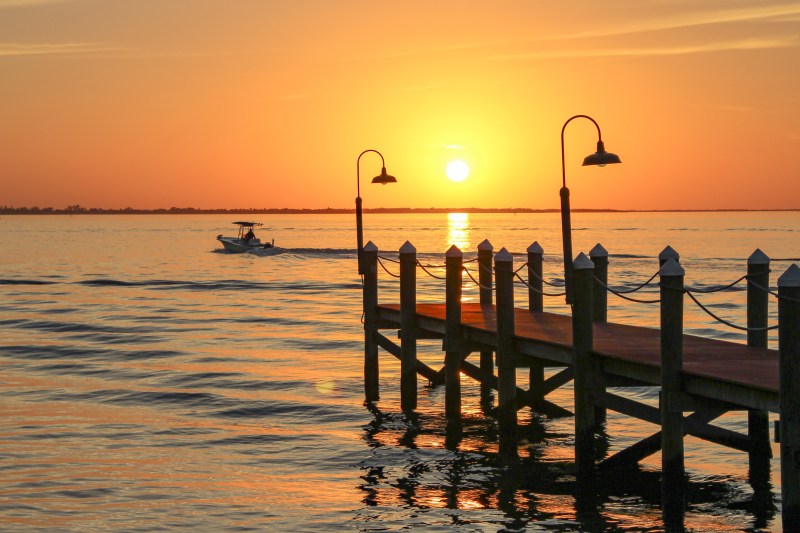
This spring or summer, you might be heading out to sea with the wind as your propellant, hiking out on a full beam reach, but have no idea what the difference is between port and starboard. Doesn’t sound quite like a plan. Before you embark on your three-hour boat tour, it might make sense to read up on a few sailing terms and buy a life jacket.
Regardless of whether this is your first sail at sea or the final sunset cruise, make sure you come prepared to master a handful of sailing knots that will not only impress the skipper but will also come in handy when you least expect it.

Bowline
Perhaps the most coveted of the nautical world, the bowline (or “boh-lin”) is a simple loop knot that tightens as the load grows. Most commonly used on smaller vessels, the bowline is generally employed to fasten the halyard to the head of the sail. It is as easy to tie as it is to untie while creating a fixed loop at the end of your line. The bowline has been around for well over 400 years.
It’s a versatile knot, sometimes referred to as the “King of Knots,” and when you see a struggling swimmer being hoisted to safety by a Coast Guard helicopter, it is usually the bowline wrapped around their body. And just like tying your shoes, to pull the bowline together, there is a rabbit and his rabbit hole.

Figure eight
The figure eight is a knot commonly found at sea and near climbing walls. It is the ultimate stopper knot, deterring the rope from slipping through its retaining device. As the pressure grows on the figure eight, its strength grows to create an almost impenetrable wall that, at the end of the day, is still easy to untie.
It’s a temporary knot that can be tied in seconds and simultaneously can be trusted with lives and vessels at stake. Whether you’re at sea and you need to fasten a stopper for the jib sheet or your partner has just yelled “belay on,” the figure-eight knot is efficient, reliable, and — you guessed it — looks exactly like a figure eight.
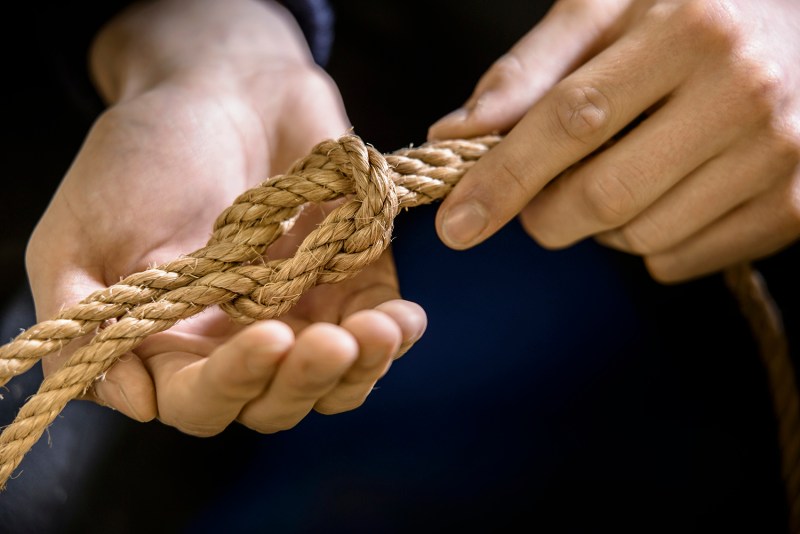
Reef knot (square knot)
Think of your shoelace knot for reference and the over-under method of tying a knot. The reef knot, or square knot, is used to fasten the two ends of the rope together, making a stopper knot. Though commonly used to tie two different lines together, it is not recommended if the lines are different sizes as one may slip out.
The reef knot dates back well over 4,000 years, and though originating within the maritime field, it is widely used in the medical profession. It was once believed by ancient Greeks that a wound bound by the reef knot would heal quicker. The square knot is no L7 weenie as it’s easy to tie, strong, and, when the day is over, easy to release.
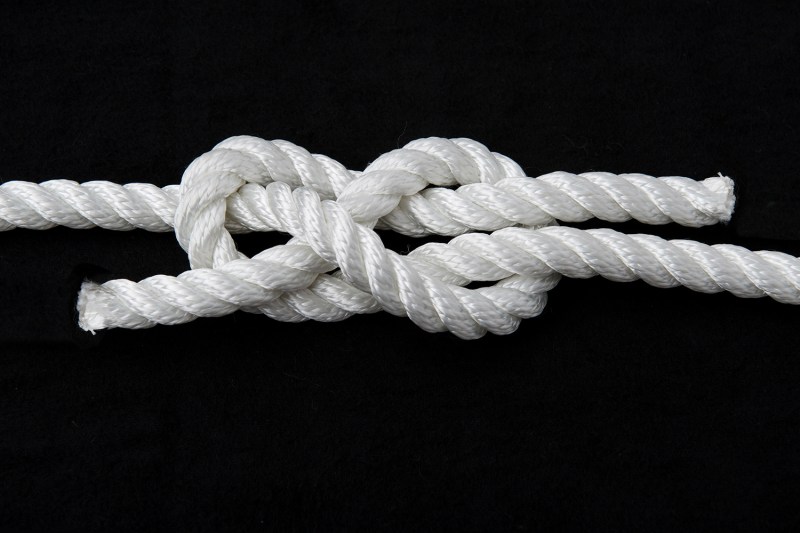
Sheet bend (weaver’s knot)
Holy sheet, that’s a great knot. The sheet bend is a knot ideal for combining two different ropes together and extending the length of your line. The knot is best suited for a load-bearing line as the knot may loosen without constant tension. Consider putting up a tarp canopy at camp and finding that your line to the tree falls a few feet short.
Grab a second line and tie a sheet bend knot to finish off your forest roof. It’s also known as a weaver’s knot as it extended the thread length in early textile mills. If you’ve got lots of ropes but not the necessary length, the sheet bend will weave your lines together.

Cleat hitch
Just like pulling the e-brake to lock your car in place, the cleat hitch is used to secure your vessel to the dock. It starts by wrapping the line around the far side of the cleat, then up and across, back toward the near side, back to the far side, and repeated until eventually the line is pulled under itself.
If the sequence is not done correctly, the cleat hitch will not jam, and your boat is off for a ghostly tour. Right alongside the bowline, the cleat hitch is a knot every boat owner should know. It’s fast and simple to tie but will require attention to detail if you plan to reboard your vessel.
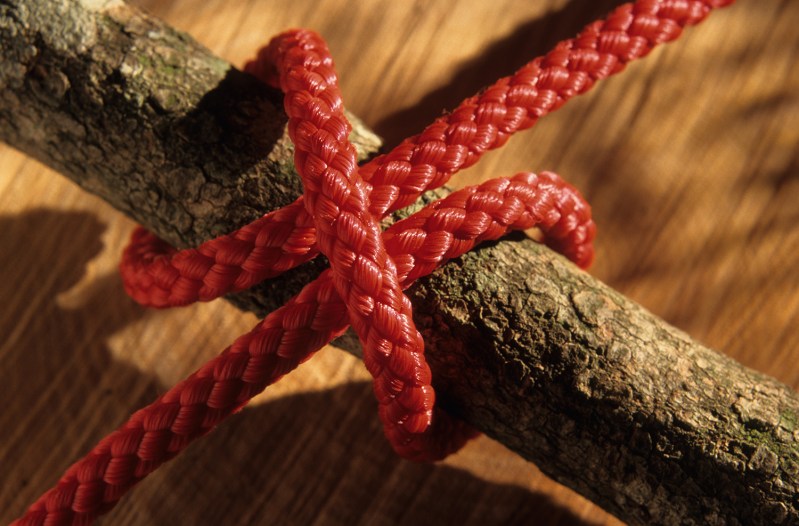
Clove hitch
Sitting toward the top of the pyramid when it comes to the importance of knots, the clove hitch (also known as a double hitch) is great for temporarily tying something to or around a cylindrical object, like a dock post. It can be adjusted as easily as it can be tied, though this is not a knot you want to leave unattended as it does have a tendency to unravel.
Imagine needing to create a railing of sorts on your boat, the clove hitch would be the perfect knot for attaching a rope to a series of posts. It can be easily tied with one hand, and its usage dates back to the early 16th century, being used in ratlines (a quickly assembled ladder system to scale the mast) and seen in sculptures and paintings. All tied and taut, the clove hitch is a great knot to have in your back pocket.
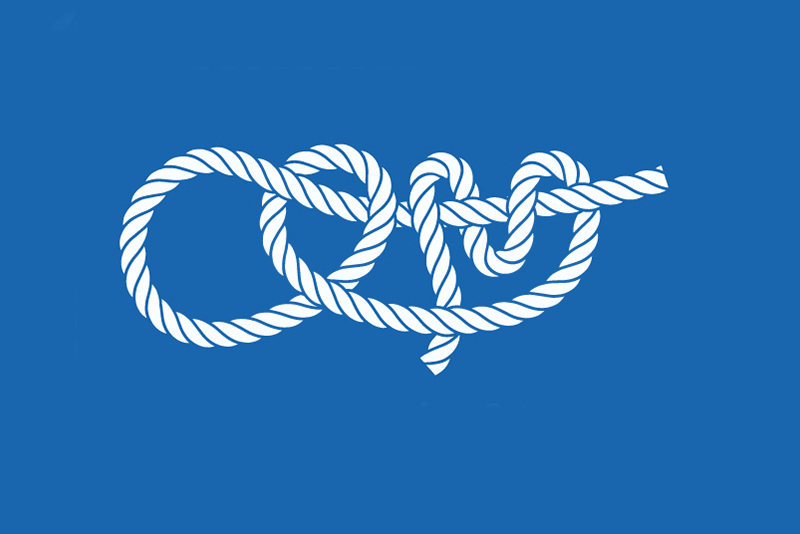
Midshipman’s hitch
The midshipman’s hitch knot creates an adjustable loop at the end of your line that, unlike other knots, can be fastened while the line is under tension. The midshipman’s hitch is strong and will stand up against heavy loads as the second loop eases the strain on the line. The adjustability of the knot makes the midshipman optimal for varying conditions and/or objects.
And in the hopefully unlikely situation that you find yourself falling overboard, the midshipman’s is the knot you need to know to fasten around yourself as you’re ideally pulled back in toward the boat. Learn it and practice it because it may save you when you’re struggling with nature’s whitecaps.
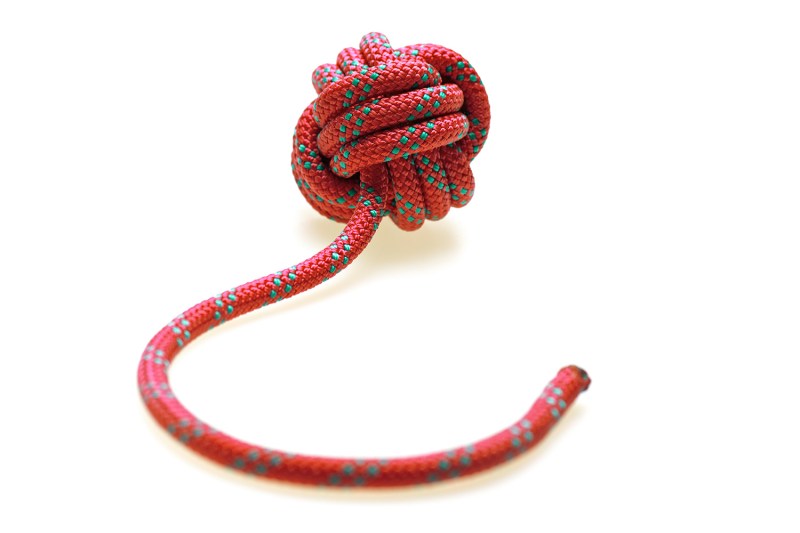
Monkey’s fist
The monkey’s fist is a bit of a bonus and is used as a weight at the end of the line so it can be thrown from bow to stern or vessel to dock. The size of the fist will vary depending on the circumference of the line, but its shape will always look like a puzzle found on the big man’s desk.
Some use it as a fashionable keychain or even a weapon as the knot is incredibly dense and will pack a serious blow to the attacker, but when you need to toss a line to an approaching ship, the monkey’s fist should be the weighted knot of choice.
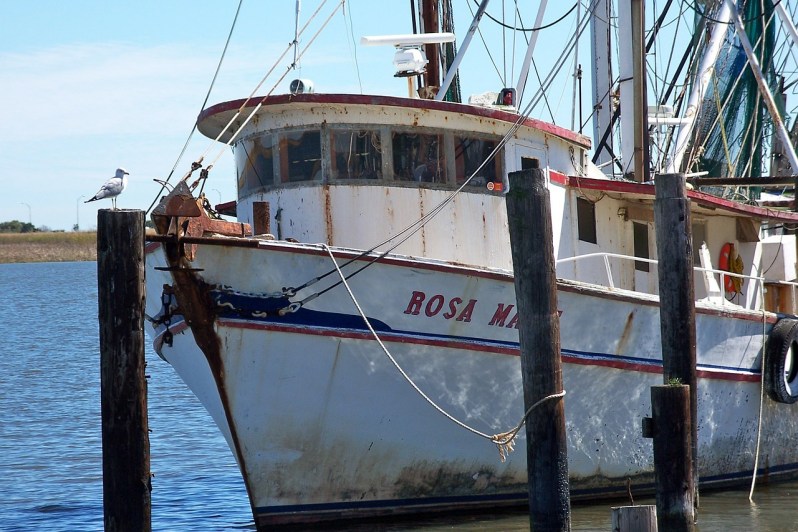
Why do sailors use knots?
This is an interesting piece of the history of sailing, as sailors use knots for a variety of crucial reasons.
Securing and rigging
Knots are essential for securely attaching lines to various parts of the boat, such as sails, masts, anchors, and other equipment. They ensure everything stays in place and functions properly, even in harsh sea conditions. Complex knots are used to create the intricate network of lines that control the sails. These knots allow sailors to adjust the sail shape and angle, effectively harnessing the wind’s power to propel the boat. Specific knots facilitate the raising and lowering of sails efficiently and safely, adapting to changing wind conditions and maneuvering requirements.
Emergency situations
Strong and reliable knots are vital for rescue operations, whether securing lifelines, rigging tow lines, or creating makeshift equipment in emergencies. Secure knots ensure anchors hold the boat firmly in place at anchorages or moorings, preventing drift and potential collisions. Sailors can use knots to create temporary repairs for damaged lines, sails, or equipment at sea, allowing them to reach safety before more permanent fixes.
Other uses
With basic knots, sailors can fashion tools like slings, nets, and even emergency shelters from readily available materials like ropes and lines. Secure knots are essential for safely lifting, lowering, and securing cargo during loading and unloading operations. Certain knots have historical uses in maritime communication, representing messages or warnings using flags or lines.
Overall, knots are vital tools for sailors, ensuring the safety, functionality, and efficiency of their vessels. They represent the accumulated knowledge and ingenuity of countless generations of mariners, adapting and evolving to meet the demands of life at sea.
Editors' Recommendations
- This van life camper van sleeps 8, goes everywhere, and you can rent it for less than a hotel would cost
- You know you’re a mountain biker if…
- Want to live in a tiny home? Here’s how much it would really cost, land and all
- The 6 best hotels for IKON pass holders this ski and snowboarding season
- The best bear spray for keeping safe in the backcountry (the one thing you should never leave home without)




